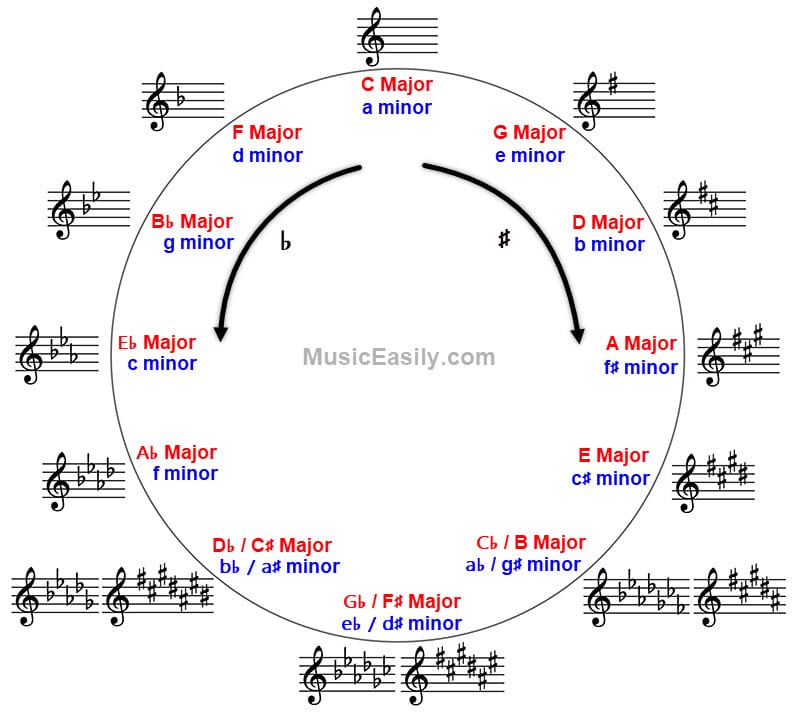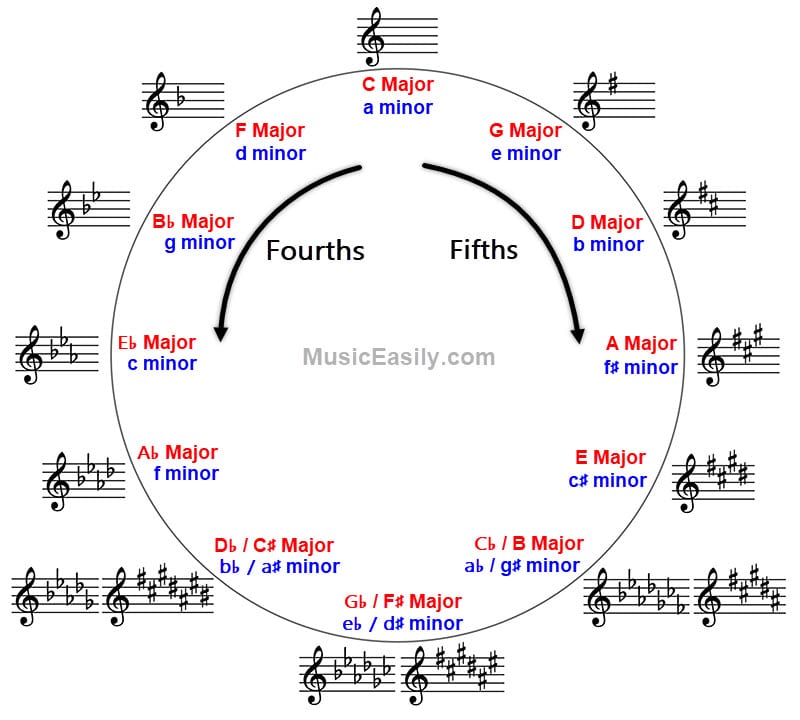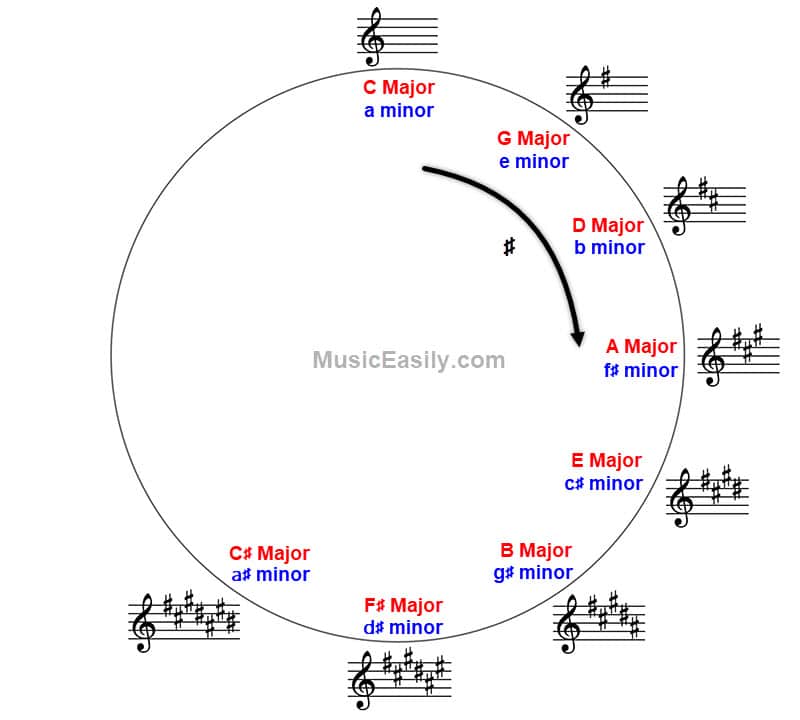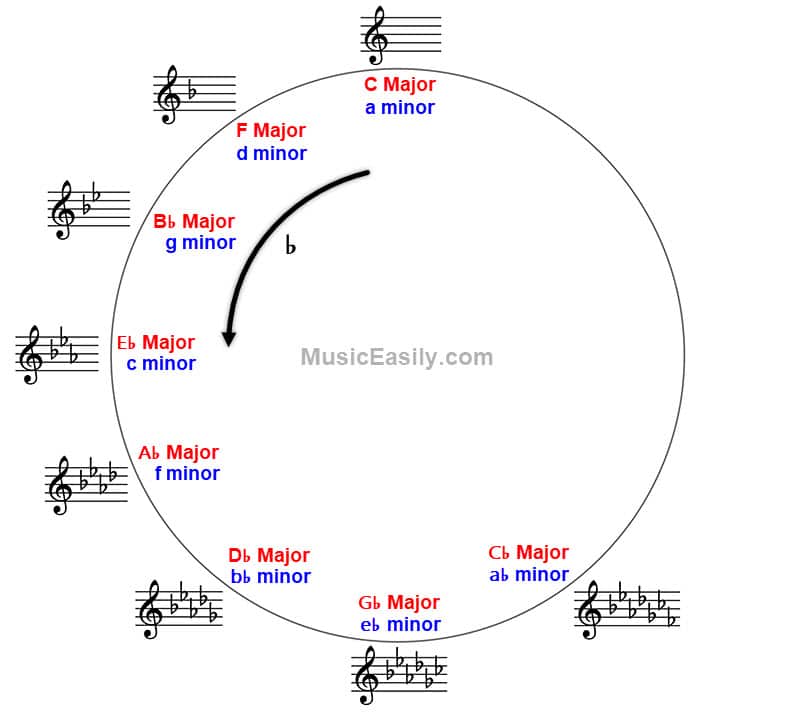The Circle of Fifths visually represents the relationships among the 12 tones of the chromatic scale, their corresponding key signatures, and the associated major and minor keys.
Introduction to The Circle of Fifths
For any musician eager to understand the mysteries of music theory, one of the most invaluable tools is the “Circle of Fifths.” sometimes written as the “Circle of 5ths.” Its name may sound complex or even intimidating at first but fear not.
The circle is a simple and visually appealing representation of the relationships among the 12 tones of the chromatic scale, their corresponding key signatures, and the associated major and minor keys.
In the Circle of Fifths, the 12 notes in the Western music scale are arranged in a circle. This circle, however, isn’t just a random assortment of notes. Instead, each note is a perfect fifth (seven half-steps) apart from its neighbor. That’s where the “fifth” in “Circle of Fifths” originates.
So, for example, if you start at C and move clockwise, you’ll arrive at G – a perfect fifth. Keep moving in the same direction; each note will be a perfect fifth from the one before it.
This concept is so valuable to musicians of all skill levels because of the insights it provides about key relationships, chord progressions, and much more. But don’t worry. We’ll be delving into these applications in the later sections of this blog post.
By the end of this post, you will have a good understanding of this fascinating musical concept, and you’ll be able to harness its potential to improve your music creation, whether you’re composing a piece, jamming with friends, or just experimenting with melodies on your instrument.
What is the Circle of Fifths?
To navigate the world of music, we need a roadmap, and the Circle of Fifths provides just that. This ingenious tool showcases the harmony and relationship between scales, keys, and chords, forming a cornerstone of Western music theory.
In its basic form, the Circle of Fifths visualizes the twelve tones of the Western music scale arranged in a specific sequence. Each note on the circle is a perfect fifth above (or a perfect fourth below) the preceding one. This alignment of notes forms the sequence we know as the Circle of Fifths.

The Structure of the Circle
The Circle of Fifths organizes the 12 tones of the chromatic scale into a circular pattern.
If you start at any point on the circle and move clockwise, each successive key is a perfect fifth higher than the one before it, and each newly added sharp in the key signature is a perfect fifth above the preceding one. This clockwise journey around the circle leads us through all 12 tones before returning to the starting point.
For example, move from G major (one sharp, F#) to D major (two sharps, F# and C#). The key of D is a perfect fifth above G, and C# (the second sharp added) is a perfect fifth above the previous sharp (F#).
Now if we move from D major to A major (three sharps, F#, C#, G#), the key of A is a perfect fifth above D, and the new sharp, G#, is a perfect fifth above the previous sharp, C#.
But the circle isn’t just about fifths. If you move counterclockwise, each successive key is a perfect fourth higher than the one before it, and each newly added flat in the key signature is a perfect fourth above the preceding one. This is why some people also refer to this tool as the “Circle of Fourths.”
For instance, if you move from F major (one flat, Bb) to Bb major (two flats, Bb and Eb), the key of Bb is a perfect fourth above F, and Eb (the second flat added) is a perfect fourth above the previous flat (Bb).
If we then move from Bb major to Eb major (three flats, Bb, Eb, Ab), the key of Eb is a perfect fourth above Bb, and the new flat, Ab, is a perfect fourth above the previous flat, Eb.

This circular journey showcases the profound structure of musical harmony. Moving clockwise shows key changes that add sharps, while moving counterclockwise demonstrates key changes that add flats.
Both directions highlight the relationship between keys, perfect fifths, and perfect fourths, unveiling the harmony that shapes the music world.
Major and Minor: One Circle, Multiple Interpretations
The Circle of Fifths isn’t just for major keys. It applies equally well to minor keys, which has led to confusion over whether there is one Circle of Fifths or two. The simple answer is: there’s only one circle, but it has multiple layers of interpretation.
In the Circle of Fifths, each major key has a relative minor key that shares the same key signature. This relative minor is always a minor third below its major counterpart. Hence, the Circle of Fifths also displays relative minors, providing another layer of understanding to this versatile tool.
This combined representation does not mean there are two circles, but rather that the single Circle of Fifths reflects the interconnected relationships between major and minor keys in Western music.
The Circle of Fifths and Key Signatures
As you delve deeper into music theory, the Circle of Fifths emerges as a practical guide to understanding key signatures. Every musician, whether a seasoned professional or a novice, knows the importance of key signatures.
They define the tonal landscape of a piece of music, governing the harmonic content. And the Circle of Fifths, by its very design, illuminates the relationship between different keys and their signatures.
To better visualize the Circle of Fifths and its implications on key signatures, it helps to consider a specific variation of the Circle of Fifths diagram focusing only on key signatures with sharps.
This approach reduces clutter and provides a clearer understanding of each key signature’s components regarding sharps.
Each successive key, moving clockwise from C, adds a sharp, which is a perfect fifth above the last. The simplification offered by this diagram variation facilitates an intuitive understanding of how sharps factor into key signatures, spotlighting the inherent harmony encapsulated in the Circle of Fifths.

Now, let’s consider a different scenario, focusing on key signatures that contain flats. Moving counterclockwise from C, the following diagram provides a more streamlined view of how flats factor into each key signature.
In this case, each successive key moving counterclockwise from C introduces a new flat, which is a perfect fourth above the preceding one. The simplification provided by this diagram underscores the clarity offered by the Circle of Fifths, even when we traverse it in the opposite direction.

When we view these Circle of Fifths diagrams, we can easily see the number of sharps or flats in each key.
Starting from C at the top of the circle, which has no sharps or flats, as we move clockwise around the circle in the first diagram, each subsequent key adds a sharp. Conversely, in the second diagram, each key adds a flat if we move counterclockwise.
Let’s consider a few examples:
- Moving one step clockwise from C in the first diagram takes you to G. G Major has one sharp (F#).
- Two steps clockwise from C lands on D. D Major has two sharps (F#, C#).
- Alternatively, one step counterclockwise from C in the second diagram takes you to F. F Major has one flat (Bb).
This pattern continues around the circle. The beauty of the Circle of Fifths lies in this visualization, making it clear how keys relate to each other. It provides a quick and easy way to determine the number of sharps or flats in any given key, an invaluable tool for those writing, studying, or performing music.
Practical Applications: How to Use the Circle of Fifths
The Circle of Fifths isn’t just a theoretical concept reserved for textbooks. Its practical applications in music composition, improvisation, and understanding chord progressions can greatly enhance a musician’s skill set. It serves as a roadmap, guiding you through the landscape of musical keys and revealing connections between them.
One of the most practical applications of the Circle of Fifths is creating chord progressions. Because of the unique harmonic relationship between the notes a fifth apart, moving through chords in this manner often produces satisfying and balanced progressions.
For example, in a typical I – IV – I – V progression in the key of G Major, we move from G to C, then again to G, and then to D, aligning with the movement around the Circle of Fifths.
In improvisation, it can be a useful guide. You’ll know what notes are likely to sound good together and why.
Tricks and Mnemonics
To newcomers, the Circle of Fifths may initially seem complex and overwhelming. However, effective tips, tricks, and mnemonic devices can significantly simplify learning.
One trick is to notice the pattern in the key signatures as you move around the Circle. Going clockwise from C (which has no sharps or flats), each key signature adds one sharp.
Conversely, moving counterclockwise from C, each key signature adds one flat. This pattern helps to predict which key signature corresponds to each note on the Circle.
The “Father Charles Goes Down And Ends Battle” Trick
An easy way to remember the order of sharps (F, C, G, D, A, E, B) in the Circle of Fifths is the sentence, “Father Charles Goes Down And Ends Battle.” Each word’s first letter represents a sharp in the key signature, in the clockwise direction on the Circle.
When considering flats (B, E, A, D, G, C, F), you reverse the sentence: “Battle Ends And Down Goes Charles’ Father.” Each word’s first letter in this sentence represents a flat in the key signature, reflecting the counterclockwise movement of the Circle.
The Power of Practice
Like any new concept, the Circle of Fifths becomes more intuitive with practice. Spend time playing around with it on your instrument.
For example, try playing the scale of each key as you move around the Circle or practice chord progressions that follow the Circle. The more you use it, the more it will become second nature to you.
Remember, the Circle of Fifths is a tool. Like any other tool, its value becomes evident only when used. So, keep practicing; soon, you’ll wonder how you got along without it.
The Importance of the Circle of Fifths
The Circle of Fifths is a powerful tool for understanding and making music. For beginners, intermediates, and experts alike, it offers myriad applications that can enhance the understanding and practice of music theory and composition.
Building Blocks for Understanding Music Theory
At the most basic level, the Circle of Fifths clearly represents the relationship between different keys and the sharps or flats that define them. This simple visual guide forms a crucial foundation for understanding musical structures and conventions.
Guiding Composition and Songwriting
The Circle is a compass for songwriters and composers, guiding key changes that sound harmonious. Changing keys according to the Circle can make transitions sound more smooth and more natural. It’s a strategy many renowned composers and songwriters use across diverse musical genres.
Enhancing Improvisation
For those interested in improvisation, the Circle can guide moving smoothly between keys and knowing which chords are likely to sound good together. It can help to predict chord progressions and to understand why certain progressions are more common than others.
Conclusion
The Circle of Fifths is undoubtedly a potent tool, not merely a music theory concept but a practical guide that simplifies the complex world of music. It offers a comprehensive approach to understanding relationships between keys, guiding composition and improvisation, and expanding your understanding of musical structures.
Whether you are taking your first steps into music theory or are already on your way to becoming a proficient musician, the Circle of Fifths remains an essential resource. It’s a map that reveals the landscape of music, providing a sense of direction that can help you navigate and explore with confidence and creativity.
For those interested in further expanding their understanding, delving into Modulation (ext. link) is a great next step. This advanced topic allows a deeper exploration into the practical application of the Circle of Fifths, highlighting the dynamic nature of key changes within music.
As you continue your musical journey, remember this: The Circle of Fifths isn’t just a chart to memorize; it’s a guide to understanding and making music. So, use it, explore it, and let it fuel your musical explorations. The beauty of music theory is that there’s always more to discover, and the Circle of Fifths can help light the way.


